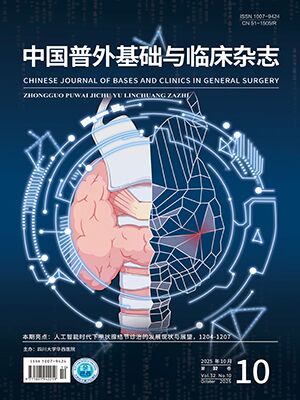Objective To analyze risk factors associated with prognosis of appendiceal adenocarcinoma using data from the Surveillance, Epidemiology, and End Results (SEER) database. Methods The patients pathologically diagnosed with appendiceal adenocarcinoma from 2005 to 2015 were extracted from the SEER database and then randomly divided into a training cohort and validation cohort in a 7∶3 ratio. The univariate and multivariate Cox regression analyses were performed in the training cohort to identify the independent risk factors for overall survival and cancer-specific survival. Based on these factors, a nomogram prediction model was constructed and subsequently internally validated. The statistical significance was defined as α=0.05. Results A total of 749 patients with appendiceal adenocarcinoma were enrolled, with 524 in the training cohort and 225 in the validation cohort. The multivariate Cox regression analysis identified that the T, N, M stages, and surgery as the independent prognostic factors for both overall survival and cancer-specific survival. Additionally, the age was identified as an independent prognostic factor for overall survival, and tumor size for cancer-specific survival. Based on these factors, the nomogram prediction models for the overall survival rate and cancer-specific survival rate were developed. The nomogram of overall survival rate achieved a C-index of 0.716 [95%CI=(0.689, 0.743)] in the training cohort and 0.695 [95%CI=(0.649, 0.740)] in the validation cohort, while the nomogram of cancer-specific survival rate showed C-index values of 0.749 [95%CI=(0.716,0.782)] and 0.746 [95%CI=(0.699, 0.793)], respectively. The area under the receiver operating characteristic curves (AUCs) for 3- and 5-year overall survival rates were 0.780 [95%CI=(0.739, 0.821)] and 0.773 [95%CI=(0.732, 0.814)] respectively in the training cohort, were 0.789 [95%CI=(0.726, 0.852)] and 0.776 [95%CI=(0.715, 0.837)] respectively in the validation cohort, which for 3- and 5-year cancer-specific survival rates were 0.813 [95%CI=(0.768, 0.858)] and 0.796 [95%CI=(0.753, 0.839)] respectively in the training cohort, were 0.813 [95%CI=(0.750, 0.876)] and 0.811 [95%CI=(0.750, 0.872)] respectively in the validation cohort. The calibration curves demonstrated good agreements between predicted and observed outcomes for both overall survival rate and cancer-specific survival rate. Conclusions Through analysis results of appendiceal adenocarcinoma patients from the SEER database reveal that advanced T, N, and M stages, as well as lack of surgery are significant risk factors for both overall survival and cancer-specific survival. The constructed nomograms for predicting overall survival and cancer-specific survival rates, which incorporate these risk factors, demonstrate strong predictive accuracy.
Citation:
ZHAO Haoyong, DONG Haifeng, GAO Fei, HAN Bin. Analysis of prognostic factors in patients with appendiceal adenocarcinoma and construction of a predictive model: based on SEER database. CHINESE JOURNAL OF BASES AND CLINICS IN GENERAL SURGERY, 2025, 32(7): 849-855. doi: 10.7507/1007-9424.202503079
Copy
Copyright © the editorial department of CHINESE JOURNAL OF BASES AND CLINICS IN GENERAL SURGERY of West China Medical Publisher. All rights reserved




